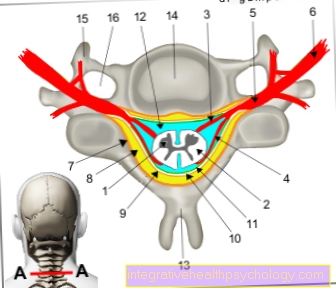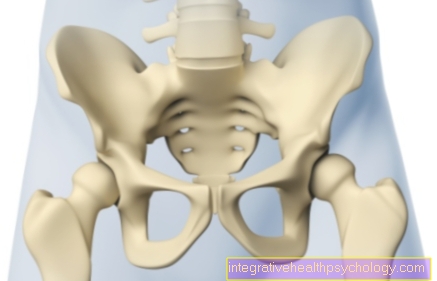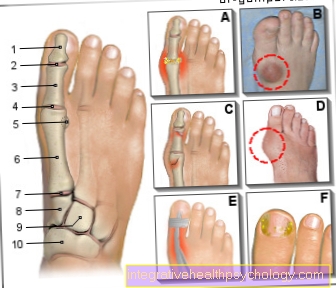Chiasm syndrome
Introduction / anatomy
The chiasm is the junction of the Optic nerves (nervus opticus). This is where the fibers of the nasal halves of the retina of both eyes cross to the opposite side. The chiasm is followed by the Optic tract.
Injuries to the visual junction (Optic chiasm) lead to chiasm syndrome.
definition
As Chiasm syndrome one denotes the occurrence of three typical features:
- bitemporal facial deficits (this means that the visual impression is only missing on the outside, so there is a view as with blinkers)
- Decrease in visual acuity on one or both sides
- Optic atrophy (Loss of nerve cells in the optic nerve)

Recognizing chiasm syndrome
What are the symptoms of chiasm syndrome?
Very typical for the chiasm syndrome are:
- frequent headaches
- Disorders in the hormonal balance and
- Double vision.
The disturbances in the hormonal balance are caused by the frequent tumors of the pituitary gland. The pituitary gland is the regulating unit in the release of hormones. The bitemporal deficits (only outside) of the visual field arise when the mass presses on the center of the optic nerve junction and thereby primarily compresses the fibers of the nasal halves of the retina. The nasal halves of the retina represent the corresponding parts of the field of vision, namely the temporal halves, i.e. the outward halves.
How is chiasm syndrome diagnosed?
In addition to the defects in the visual field, radiographic changes in the sella turcica (Turkish saddle) are also determined. This is a bony structure of the skull base, in which the pituitary gland (pituitary gland) comes to rest.
Treating Chiasma Syndrome
How is chiasm syndrome treated?
Pituitary tumors must be removed. After the relief, the visual acuity and field of vision can recover. However, long-term damage cannot be ruled out.
Preventing Chiasm Syndrome
What are the causes of chiasm syndrome?
Usually the cause is a mass (mostly tumors) that presses on the chiasm. In most cases it is a tumor of the pituitary gland (pituitary gland), more rarely the symptoms are caused by a tumor that originates from the meninges (meningioma). Furthermore, an aneurysm (widening) of vessels (often carotid artery = med. Carotid) can compress the optic nerve junction and cause discomfort. Masses of the optic nerve itself (glioma = benign tumor) can also extend to the chiasm.

Illustration brain
- Cerebrum
- Cerebellum (cerebellum)
- Spinal cord
- Pituitary gland (pituitary gland)





























